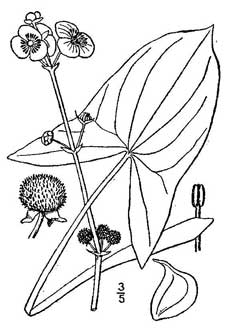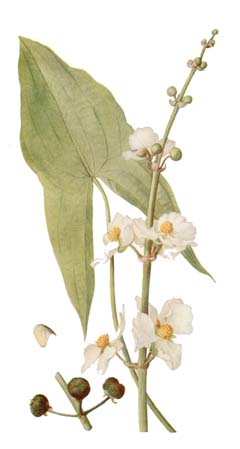 |
|
https://edibleplants.org/ |
 |
| https://edibleplants.org/ |
Translate this page:
Summary
Physical Characteristics

 Sagittaria latifolia is a PERENNIAL growing to 1.2 m (4ft) by 0.3 m (1ft in).
Sagittaria latifolia is a PERENNIAL growing to 1.2 m (4ft) by 0.3 m (1ft in).
See above for USDA hardiness. It is hardy to UK zone 7 and is not frost tender. It is in flower from July to September, and the seeds ripen from August to September. The species is monoecious (individual flowers are either male or female, but both sexes can be found on the same plant) and is pollinated by Insects.
Suitable for: light (sandy), medium (loamy) and heavy (clay) soils. Suitable pH: mildly acid, neutral and basic (mildly alkaline) soils. It cannot grow in the shade. It prefers wet soil and can grow in water.
UK Hardiness Map
US Hardiness Map
Synonyms
Sagitta latifolia (Willd.) Nieuwl. Sagittaria esculenta Howell. Sagittaria gigantea Riddell [Illegitimate]. Sagittaria gracilis Pursh. Sagittaria hastata Pursh. Sagittaria longirostra (Micheli) J.G.Sm. Sagittaria obtusa Muhl. ex Willd. [Illegitimate]. Sagittaria ornithorhyncha Small. Sagittaria planipes Fernald. Sagittaria pubescens Muhl. Sagittaria simplex Pursh. Sagittaria variabilis Engelm.Sagittaria viscosa C.Mohr
Plant Habitats
Pond; Bog Garden;
Edible Uses
Edible Parts: Root
Edible Uses:
Root - raw or cooked[62, 105]. Excellent when roasted, the texture is somewhat like potatoes with a taste like sweet chestnuts[85, 92, 94, 159, 256]. The tubers can be eaten raw but they are rather bitter (especially the skin)[85, 102, 159]. It is best to remove this skin after the tubers have been cooked[183]. The tubers can also be dried and ground into a powder, this powder can be used as a gruel or mixed with cereal flours and used to make bread[85, 94]. The N. American Indians would slice the boiled roots into thin sections and then string them on ropes to dry in much the same way as apples[183].The egg-shaped tubers are 4 - 5cm long and are borne on the ends of slender roots, often 30cm deep in the soil and some distance from the parent plant[85, 92, 94]. The tubers are best harvested in the late summer as the leaves die down[92, 95]. They cannot be harvested by pulling out the plant since the tops break off easily, leaving the tubers in the ground[213].
References More on Edible Uses
Medicinal Uses
Plants For A Future can not take any responsibility for any adverse effects from the use of plants. Always seek advice from a professional before using a plant medicinally.
Digestive Poultice
A poultice of the leaves has been used to stop milk production[222]. A tea made from the roots is used as a digestive[222, 257]. A poultice of the roots is used in the treatment of wounds and sores[222, 257].
References More on Medicinal Uses
The Bookshop: Edible Plant Books
Our Latest books on Perennial Plants For Food Forests and Permaculture Gardens in paperback or digital formats.

Edible Tropical Plants
Food Forest Plants for Hotter Conditions: 250+ Plants For Tropical Food Forests & Permaculture Gardens.
More

Edible Temperate Plants
Plants for Your Food Forest: 500 Plants for Temperate Food Forests & Permaculture Gardens.
More

More Books
PFAF have eight books available in paperback and digital formats. Browse the shop for more information.
Shop Now
Other Uses
References More on Other Uses
Cultivation details
A pond or bog garden plant, it requires a moist or wet loamy soil in a sunny position[1]. Prefers shallow, still or slowly flowing water up to 12cm deep[1, 56]. Hardy to at least -20°c[187]. A polymorphic species[92].
References Carbon Farming Information and Carbon Sequestration Information
Temperature Converter
Type a value in the Celsius field to convert the value to Fahrenheit:
Fahrenheit:
The PFAF Bookshop
Plants For A Future have a number of books available in paperback and digital form. Book titles include Edible Plants, Edible Perennials, Edible Trees,Edible Shrubs, Woodland Gardening, and Temperate Food Forest Plants. Our new book is Food Forest Plants For Hotter Conditions (Tropical and Sub-Tropical).
Shop Now
Plant Propagation
Seed - best sown as soon as it is ripe in a pot standing in about 5cm of water. Prick out the seedlings into individual pots when they are large enough to handle, and gradually increase the depth of water as the plants grow until it is about 5cm above the top of the pot. Plant out in late spring or early summer of the following year. Division of the tubers in spring or autumn. Easy. Runners potted up at any time in the growing season.
Other Names
If available other names are mentioned here
Native Range
NORTHERN AMERICA: Canada (Québec, Nova Scotia, Ontario, Prince Edward Island, New Brunswick, Saskatchewan, Alberta, Manitoba, British Columbia (southwest)), United States (Connecticut, Indiana, Maine, Massachusetts, Michigan, New Hampshire, New Jersey, New York, Ohio, Pennsylvania, Rhode Island, Vermont, West Virginia, Illinois, Iowa, Kansas, Minnesota, Missouri, Nebraska, North Dakota, Oklahoma, South Dakota, Wisconsin, Colorado, Alabama, Arkansas, Delaware, District of Columbia, Florida, Georgia, Kentucky, Louisiana, Maryland, Mississippi, North Carolina, South Carolina, Tennessee, Virginia, Texas, California), Mexico (Durango, Sinaloa, Tamaulipas, Campeche, Chiapas, Ciudad de México, Guanajuato, Hidalgo, Jalisco, México, Michoacán de Ocampo, Morelos, Nayarit, Oaxaca, Puebla, Querétaro, Tabasco, Tlaxcala, Veracruz de Ignacio de la Llave) SOUTHERN AMERICA: United States (Puerto Rico), Guatemala, Honduras, Nicaragua, Venezuela, Colombia, Ecuador
Weed Potential
Right plant wrong place. We are currently updating this section.
Please note that a plant may be invasive in one area but may not in your area so it’s worth checking.
Conservation Status
IUCN Red List of Threatened Plants Status :

Growth: S = slow M = medium F = fast. Soil: L = light (sandy) M = medium H = heavy (clay). pH: A = acid N = neutral B = basic (alkaline). Shade: F = full shade S = semi-shade N = no shade. Moisture: D = dry M = Moist We = wet Wa = water.
Expert comment
Author
Willd.
Botanical References
60200274
Links / References
For a list of references used on this page please go here
Readers comment
© 2010, Plants For A Future. Plants For A Future is a charitable company limited by guarantee, registered in England and Wales. Charity No. 1057719, Company No. 3204567.